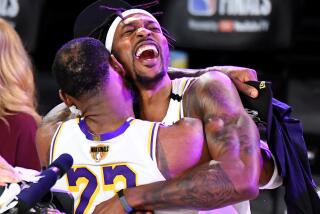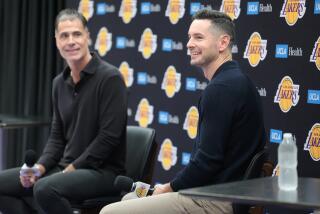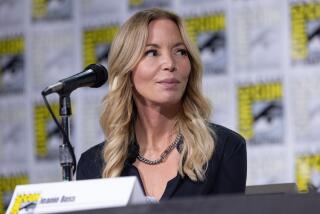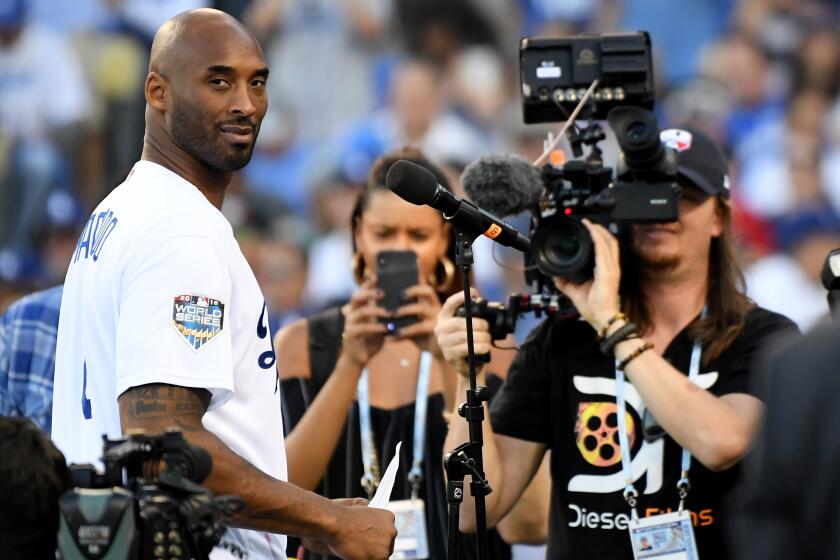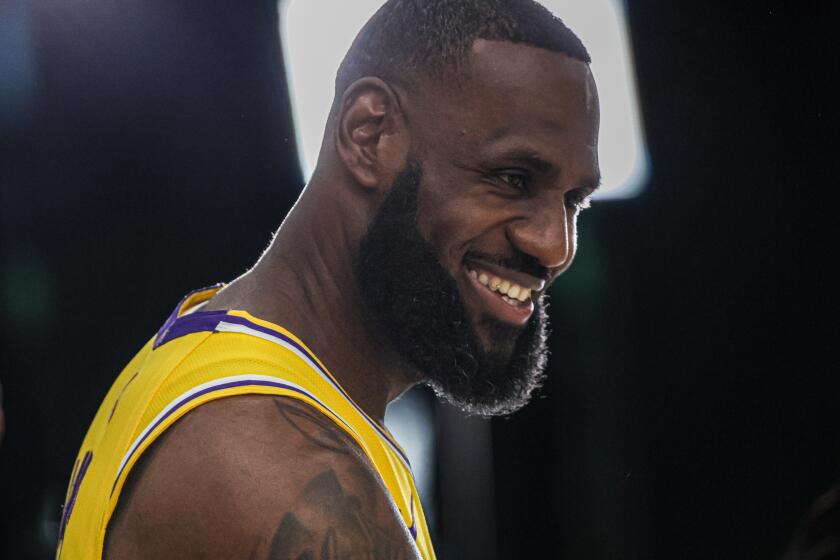Rebuilding Block
The empire strikes back, however belatedly.
Before this week, the question was whether the Lakers would ever be back, or if they were going to sink out of sight like Atlantis or Boston.
The question persisted throughout this storm-tossed season with their coach fleeing, their star running off players they were trying to sign and no one able to explain what they were doing -- leaving the impression they didn’t know -- before the owner stepped up to say they could be back in the Western Conference finals in a year or two.
By then I thought we had seen the last of that period in NBA history, but two things happened, both surprises to moi: Phil Jackson returned as coach, offering the possibility of stabilizing their bedraggled crew in the short term; and, just as important, their long-term strategy remained in place.
There was one little problem with Jackson’s return. His three-year deal meant that as far as winning titles was concerned, he could only start them off in the right direction.
So, what’s good for Jackson’s second term wasn’t necessarily what’s best for the Lakers in the end.
All these forces came into play in the last week, in which the new Jackson/Jerry Buss/Mitch Kupchak regime began to define itself.
Late on the pre-draft circuit, Kupchak and the scouts had fallen hard for prep center Andrew Bynum, himself a late bloomer who had only recently lost enough weight to emerge as a star of his class at the McDonald’s Classic.
Kupchak had two problems: Someone else might grab Bynum ... and Jackson might not want him, because he wouldn’t be ready to do much until Phil was working on his farewell address.
Happiness in the draft these days is drafting behind Toronto Raptor General Manager Rob Babcock, who somehow decided the big man he wanted was not Channing Frye, the no-brainer choice, but Charlie Villanueva, a no-brainer in his own right.
The New York Knicks, who wanted a big man, took Frye ... and the Golden State Warriors, another dizzy outfit, decided they wanted a short power forward, Ike Diogu, to go with their big one, Troy Murphy.
That left Bynum for Jackson, who didn’t like the idea of high school players when he had five-year deals. For a week, there were reports from insiders that Phil wasn’t doing back flips over this one.
There was also a concern about Bynum’s medical history. Last week, Bynum was rated a no-go.
The projected Laker pick was 6-foot-9 Spanish power forward Fran Vazquez. Jackson is big on power forwards; in Chicago where he had Horace Grant and Dennis Rodman, they were the key to his defense, which was the key to his six titles.
Unfortunately, many people, including some Laker officials, thought Vazquez was pretty ordinary for a No. 10 pick, like a smaller version of Chris Mihm.
By draft day, Vazquez was out of the mix. If Frye and Bynum had been gone, the Lakers would have taken Sean May, whom they liked a lot ... but who is 6-7 in bare feet.
The Lakers note that makes him 6-8 1/2 in shoes -- but that also makes Elton Brand 6-9 1/2 in shoes and Brand might be as short as an inside player can be. With all his wiles, his 9-2 vertical reach (five inches more than May’s 8-9), his 275-pound body and his warrior attitude, Brand still has trouble getting the ball to the rim in traffic.
For a week, the organization debated it. In the end, the decision wasn’t made by Jackson, as everyone thought it would be, but by Kupchak with a nod from Buss to go for the greatness he saw in Bynum, and it was the right one.
Kupchak says Jackson was on board all the way, but others aren’t as sure. Afterward, someone asked a Laker official if Jackson had been against taking Bynum.
“I’m sure he was,” the official said.
The good news for the franchise was, Buss didn’t care.
Buss has a when-the-going-gets-tough-the-tough-go-on-vacation style and he certainly isn’t the spokesman his organization needs. But when it comes to a choice between settling for being good and milking his cash cow or daring to be great, he comes down on the side of greatness every time.
There are three things that made the Lakers great over the years: 1) Jack Kent Cooke and Buss, the flamboyant owners who demanded it; 2) players like Wilt Chamberlain, Kareem Abdul-Jabbar and Shaquille O’Neal, who wanted to come here, and 3) Jerry West, who starred on Cooke’s teams and ran Buss’ teams.
Other fallen giants like the ‘80s Celtics and ‘90s Knicks took their eyes off the prize, saying things like “You can’t rebuild here” and trying to stay competitive. This devolved to hoping to finish No. 8 since “Anything can happen in the playoffs.”
When West rebuilt, it was from scratch (remember 1993 when he traded Sam Perkins, his best player, for rookie Doug Christie, after which the team tumbled and Coach Randy Pfund was fired?) with the aim of being great again.
With West gone and the dynasty in ruins, Kupchak was reviled from the day Buss ordered him to pack up their big guy and put him on a plane. (Remember that fan asking Kupchak to step down at their town hall this spring? Remember Jim Buss’ rise to a position of power, in which he began speaking for the team?)
Nevertheless, before last week, all Kupchak ever had to work with was a mandate to make the best deal he could for O’Neal -- that Shaq wouldn’t reject (there went Jermaine O’Neal) -- and some draft picks in the 20s.
With his first lottery pick Tuesday, Kupchak stepped up with a true West-type choice, the big kid with the huge promise, even if it’s only promise and whatever he’ll be, it won’t be for years.
Here’s the hopeful scenario for Bynum’s first three seasons:
* 2005-2006: Totally lost for the first half. Gets a few minutes in the second half but isn’t disappointed like Darko Milicic, who refused to go into a game as a rookie. Bynum plays hard and gets an occasional thunderous dunk when someone throws him the ball under the basket, delighting the fans.
* 2006-2007: Picks up where he left off as a rookie, continues to track up but is still up to only 10-15 minutes a game by the end of the season. Fans get fidgety.
* 2007-2008: Callers to talk shows begin comparing his progress to everyone drafted behind him, but he continues to track up. Gets more playing time but still less than 24 minutes a game. He begins to show a move or two at the offensive end.
Then, of course, there’s the Eddy Curry scenario ...
By Curry’s second season with the Bulls, the local papers were calling for him to be traded. By his fourth, the team was shopping him and scouts like Golden State’s Mitch Richmond were coming in to see him when -- bingo! -- Curry got it.
Now there’s the question of a heart problem as Curry becomes a restricted free agent so we still don’t know how this one will come out.
It isn’t easy, but if it works, you’re a long way ahead of where you were. It’s only the first step of a long journey but after what the Lakers went through in the last 12 months, one is a lot.
*
(BEGIN TEXT OF INFOBOX)
Kup-check
Key off-season transactions by Mitch Kupchak since he became Laker general manager:
2000 Signed G Isaiah Rider; traded F Glen Rice to New York; acquired F Horace Grant.
2001 Signed free-agent G Mitch Richmond and F-C Samaki Walker.
2003 Drafted forwards Luke Walton and Brian Cook.
2003 Signed free-agent F Karl Malone and G Gary Payton.
2004 Traded C Shaquille O’Neal to Miami for F Lamar Odom, F Brian Grant, F Caron Butler.
2004 Traded Payton, F Rick Fox to Boston for C Chris Mihm, F Jumaine Jones, G Chucky Atkins.
More to Read
All things Lakers, all the time.
Get all the Lakers news you need in Dan Woike's weekly newsletter.
You may occasionally receive promotional content from the Los Angeles Times.
